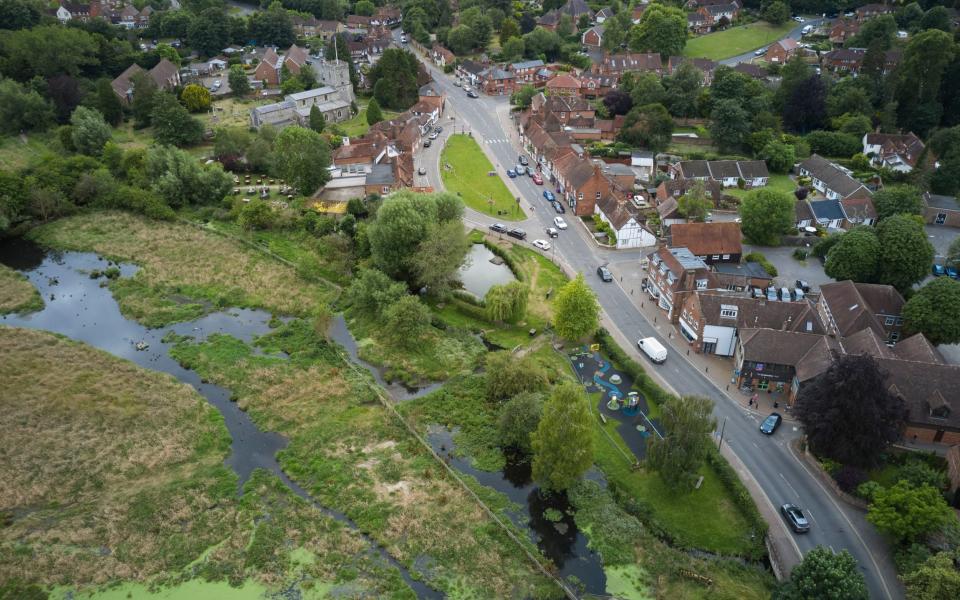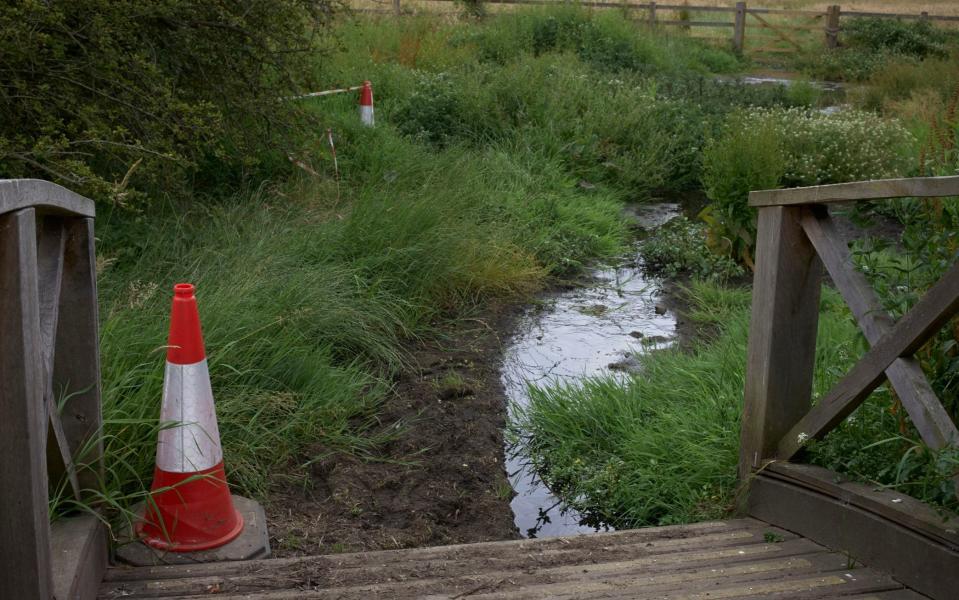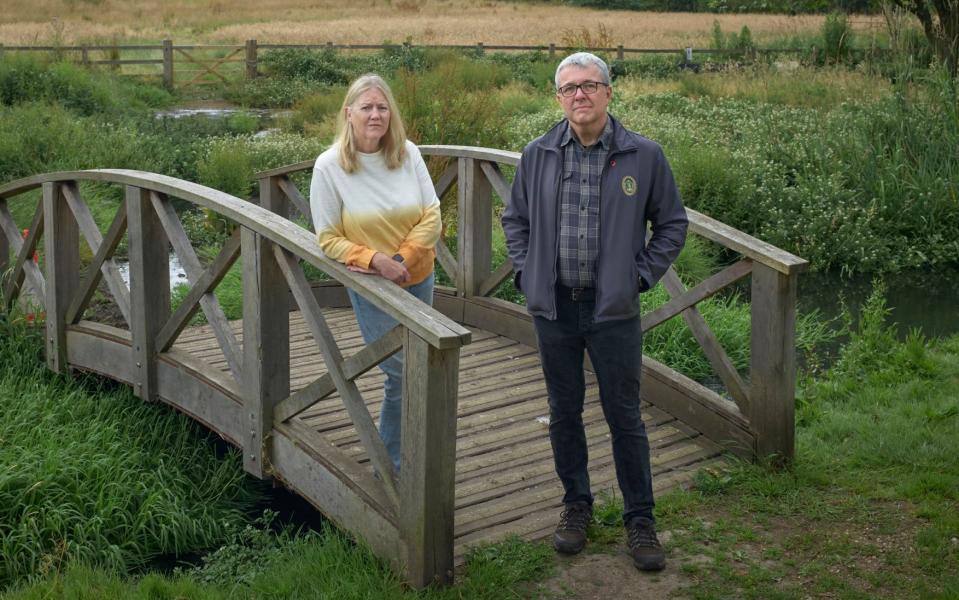‘It’s like living in an open sewer’: How Britain’s prettiest village became its smelliest

It would be an exaggeration to say the smell hits you as soon as you arrive at Chalfont St Giles, but it doesn’t take long for the unmistakable noxious stench to fill your nostrils.
This picturesque pocket of Buckinghamshire is now not only Britain’s “Best Kept Village” (it has won the annual competition six times), but its smelliest.
The aroma of sewage wafts across the pristine village green – a semi-circle of immaculate turf framed by red, white and blue bunting. It catches you in the queue for the deli, which sells posh preserves and flat whites.
It has emptied out the newly renovated pub garden, which tapers down a fairy-lit path to picnic tables on the banks of the river. Put simply, it stinks.
When the weather briefly warmed up in late June, what had been a mysterious whiff became an all-encompassing stench. “It just got more and more overpowering,” claims Jane Chamberlain of the parish council. “One end of the village couldn’t open their windows; couldn’t go out in their gardens.”
The meadow to one side of the village is a floodplain, and baffled locals initially thought the smell was stagnant water. “But it just kept getting worse and worse,” Chamberlain adds.
“The first we knew that anything was wrong was way back in January, when we were advised that there had been an ‘incident’. What we didn’t realise was that they were continuously pumping [sewage] for over 3,500 hours, from January to a couple of weeks ago.”

“They” refers to Thames Water, which was found to have been dumping raw sewage into the River Misbourne, an ecologically sensitive chalk stream that runs right through the centre of the village, for a continuous period of five months.
Information taken from Thames Water’s discharge map showed that the Amersham balancing tanks – overflow tanks used to manage the flow of wastewater – which feed into the River Misbourne, started a storm overflow discharge on January 25 and carried on discharging for 3,697 hours, only ceasing on June 27.
The people of Chalfont St Giles, which has a population of roughly 4,700, were understandably outraged.
“It’s a sense of disappointment and frustration that this has been allowed to happen,” says Chamberlain. “We know we’re not the only village to have been affected by this. But we’re just very disappointed they’ve done this [to us].”

The Misbourne is one of the eight chalk streams flowing through the Chiltern Hills. It runs for 16 miles through several Buckinghamshire villages, including Chalfont St Giles and neighbouring Chalfont St Peter.
Understandably, its well-heeled residents are kicking up a stink. “I’ve been noticing it since the middle of May,” says parish councillor Robert Gill. “All of a sudden, it’s like, ‘Oh, what is that?’ It’s just a horrible stench.” Gill says a specialist team dispatched by Thames Water found that levels of contamination were high.
They lay the blame solely at the door of Thames Water, which serves nearly a quarter of England.

The company had pumped 72 billion litres of sewage into the Thames River since 2020 as of July last year, according to a freedom of information request submitted by the Liberal Democrats.
A report for 2022-2023 recorded 8,014 sewage spills and its ageing systems leak approximately 600 million litres of water per day. It has been accused of rampant financial mismanagement, having racked up £14.7 billion in debt but still paid over £200 million in dividends to other companies within the group in the past five years.
The parish council has been forced to pull out of this year’s “Best Kept Village” competition due to the foul smell. The village show organised by the parish council, a highlight of the year for this close-knit community, has been cancelled. “It’s completely ruined us this year,” says Chamberlain. “It feels like Thames Water has played it down.”
“It’s like living in an open sewer,” says Gordon Patrick, 84, whose red-brick cottage is opposite the village green. “Late afternoon it starts to drift up, and the smell in the evening is unbearable. It’s a lovely village that we’ve got. But we’ve had terrible conditions.”

Patrick’s wife, Beryl, 82, claims: “A friend of ours has the river running through her garden – she was trying to clear it and became very sick because the river splashed her. The water was black. Up until last week, the smell has been unbelievable. [My neighbour] was wearing a mask.”
The river footpath, duck pond and a newly completed children’s play area have been closed off due to the pollution, much to the dismay of Xenia, aged four. “We love to go in there and now it’s cancelled,” she says indignantly.
“We walk home from school and pop in the playground for a bit,” says her mother, Vikki, aged 39. The play park closure is just one of the ways the smell has ruined their summer so far. “It’s not so bad today, but when it was warmer last week, [there] was a stench. And I think it’s a shame, because people aren’t sitting in the pub garden anymore. It seems to be worse in the evenings.”
Chalfont St Giles has a rich history and a wealth of celebrity connections. It was mentioned in the Domesday Book of 1086 – making it at least 938 years old – and was home to 17th-century poet John Milton when he wrote Paradise Lost. More recently, it made headlines as the birthplace of former Liberal Democrat leader Nick Clegg and the former home of Noel Gallagher. Ozzy and Sharon Osbourne live nearby.
Such is its air of quintessential English charm that it served as Walmington-on-Sea for the first Dad’s Army film in 1971.
The average house price last year was a staggering £967,554, owing to the village’s quick connection to London (a train from nearby Gerrards Cross to London Marylebone takes just 25 minutes on average), its reputation as one of the country’s most exclusive commuter hotspots and its position on the edge of the Chiltern Hills (AONB).

Mercifully, the smell has improved over the past week as the weather has cooled. On the high street, the gentle breeze means you only get a mere whiff of sewage. But it hasn’t yet disappeared. Vinny Joner, 46, who runs The Feathers pub on the high street, says it has “stunk for months”.
His pub, which would normally be benefiting from summer footfall and the Euros, has been notably empty.
Even on a cool, drizzly day, the smell is unmistakable as you walk down to the riverbank. The previously crystal-clear water of the chalk stream, a globally rare habitat where you can often see brown trout, is a murky brown. “This is nothing,” claims Chamberlain. “We couldn’t have stood out here a week ago.”
“Our plan is to get the village back to normal as soon as we can,” adds Gill. They have asked Thames Water to clean up the contaminated areas and to take steps to ensure this doesn’t happen again. “As soon as we can prove the water quality has returned to [normal] we will reopen everything.”
A volunteer group from Misbourne River Action is primed to help clear the area and get it ready for entry into next year’s Best Kept Village competition.
A Thames Water spokesman said: “Our region has experienced the eighth wettest winter on record, resulting in exceptionally high groundwater and river levels. This groundwater and river floodwater then entered our sewers and filled the Amersham storm tanks, meaning they are full and are discharging diluted wastewater into the River Misbourne, for which we are sorry.
“We’ve put transparency at the heart of what we do, and we were the first water company to publish a real time data map. Our monitor at our Amersham storm tanks site is now publishing this data for the public to see and while all discharges are unacceptable, the sewage system was historically designed to work in this way, to prevent sewage backing up into people’s homes.
“We know how much rivers are loved and enjoyed by everyone, and we are committed to seeing our waterways thrive. Our engineers are using filter units at the storm tanks and are working hard to minimise the impact to the river.”

 Yahoo News
Yahoo News 
